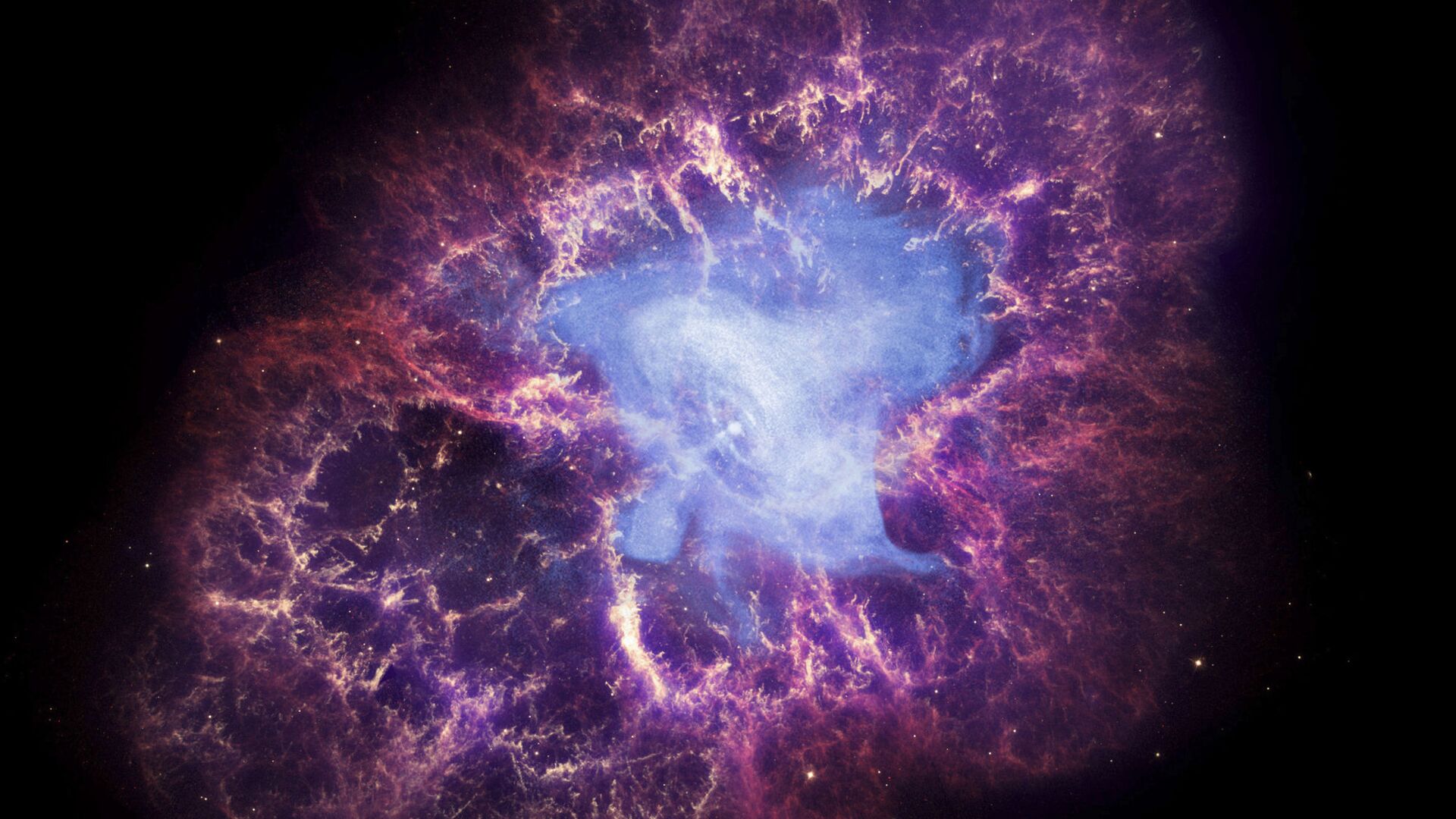https://sputnikglobe.com/20211022/astronomers-witness-explosive-star-that-could-help-develop-early-warning-system-1090147123.html
Astronomers Witness Explosive Star That Could Help Develop Early Warning System
Astronomers Witness Explosive Star That Could Help Develop Early Warning System
Sputnik International
For the first time, NASA’s Hubble Space Telescope gave astronomers an “unprecedented” view of a star exploding 60 million light-years away and becoming a... 22.10.2021, Sputnik International
2021-10-22T23:33+0000
2021-10-22T23:33+0000
2023-04-12T16:59+0000
nasa
star
space
https://cdn1.img.sputnikglobe.com/img/07e4/08/11/1080190824_0:448:2048:1600_1920x0_80_0_0_f1fd9c0f35dec7a1f7497161e413e7b3.jpg
Hubble's data, combined with other observations, allowed researchers to understand what was happening to the star just before it died, and examine the material close to the supernova that was ejected from the star in the last year of its life, according to NASA.The supernova, also known as SN 2020fqv, was discovered in April 2020 by the Zwicky Transient Facility at the Palomar Observatory in San Diego, California. The star’s location is said to be Butterfly Galaxies — a pair of members located in the Virgo galaxy cluster."This is a different situation, because we really know what's going on and we actually see the death in real time."Based on these observations, the star is expected to have died millions of years ago.Astronomers were able to get “holistic views” of the event, capturing detailed pictures of the stars in their “final moments” and how they exploded.Theoretical models and ultra-rapid observations of the supernova helped the team determine the star's mass to be about 14 to 15 times the mass of the sun before it exploded. In order to understand how massive stars die, it is imperative to understand their mass."People use the term 'Rosetta Stone' a lot. But this is the first time we've been able to verify the mass with these three different methods for one supernova, and all of them are consistent," Tinyanont said. "Now we can push forward using these different methods and combining them because there are a lot of other supernovas where we have masses from one method, but not another."Scientists are using the behavior that they witnessed before this supernova to assist them in finding other stars on the brink of explosion — that tend to be more active and release material.
Sputnik International
feedback@sputniknews.com
+74956456601
MIA „Rosiya Segodnya“
2021
Adriana Montes
https://cdn1.img.sputnikglobe.com/img/07e5/09/10/1089141767_0:89:1270:1359_100x100_80_0_0_83cb4d432e11a31f4608d8cb59ecf006.jpg
Adriana Montes
https://cdn1.img.sputnikglobe.com/img/07e5/09/10/1089141767_0:89:1270:1359_100x100_80_0_0_83cb4d432e11a31f4608d8cb59ecf006.jpg
News
en_EN
Sputnik International
feedback@sputniknews.com
+74956456601
MIA „Rosiya Segodnya“
Sputnik International
feedback@sputniknews.com
+74956456601
MIA „Rosiya Segodnya“
Adriana Montes
https://cdn1.img.sputnikglobe.com/img/07e5/09/10/1089141767_0:89:1270:1359_100x100_80_0_0_83cb4d432e11a31f4608d8cb59ecf006.jpg
nasa, star, space
Astronomers Witness Explosive Star That Could Help Develop Early Warning System
23:33 GMT 22.10.2021 (Updated: 16:59 GMT 12.04.2023) For the first time, NASA’s Hubble Space Telescope gave astronomers an “unprecedented” view of a star exploding 60 million light-years away and becoming a supernova in “real-time,” which may provide a “warning system” for other stars on the brink of death.
Hubble's data, combined with other observations, allowed researchers to understand what was happening to the star just before it died, and examine the material close to the supernova that was ejected from the star in the last year of its life,
according to NASA.
The supernova, also known as SN 2020fqv, was discovered in April 2020 by the Zwicky Transient Facility at the Palomar Observatory in San Diego, California. The star’s location is said to be Butterfly Galaxies — a pair of members located in the Virgo galaxy cluster.
"We used to talk about supernova work like we were crime scene investigators, where we would show up after the fact and try to figure out what happened to that star,” Ryan Foley, an assistant professor at the University of California, said in a
statement.
"This is a different situation, because we really know what's going on and we actually see the death in real time."
Based on these observations, the star is expected to have died millions of years ago.
Astronomers were able to get “holistic views” of the event, capturing detailed pictures of the stars in their “final moments” and how they exploded.
"We rarely get to examine this very close-in circumstellar material since it is only visible for a very short time, and we usually don't start observing a supernova until at least a few days after the explosion," added Samaporn Tinyanont, lead author on the study's paper,
published in the Monthly Notices of the Royal Astronomical Society.
Theoretical models and ultra-rapid observations of the supernova helped the team determine the star's mass to be about 14 to 15 times the mass of the sun before it exploded. In order to understand how massive stars die, it is imperative to understand their mass.
"People use the term 'Rosetta Stone' a lot. But this is the first time we've been able to verify the mass with these three different methods for one supernova, and all of them are consistent," Tinyanont said. "Now we can push forward using these different methods and combining them because there are a lot of other supernovas where we have masses from one method, but not another."
Scientists are using the behavior that they witnessed before this supernova to assist them in finding other stars on the brink of explosion — that tend to be more active and release material.
"This could be a warning system," Foley said. "So if you see a star start to shake around a bit, start acting up, then maybe we should pay more attention and really try to understand what's going on there before it explodes. As we find more and more of these supernovas with this sort of excellent data set, we'll be able to better understand what's happening in the last few years of a star's life."




